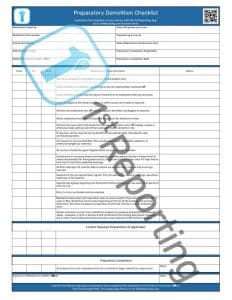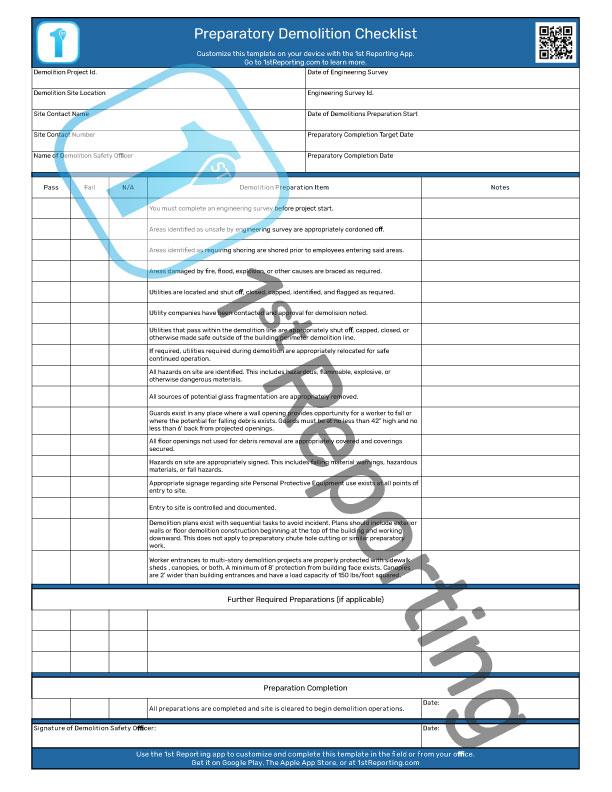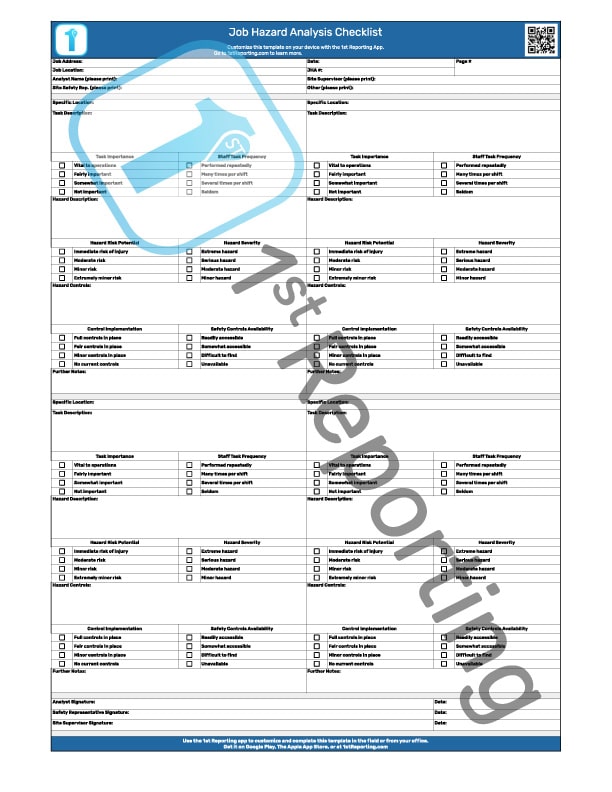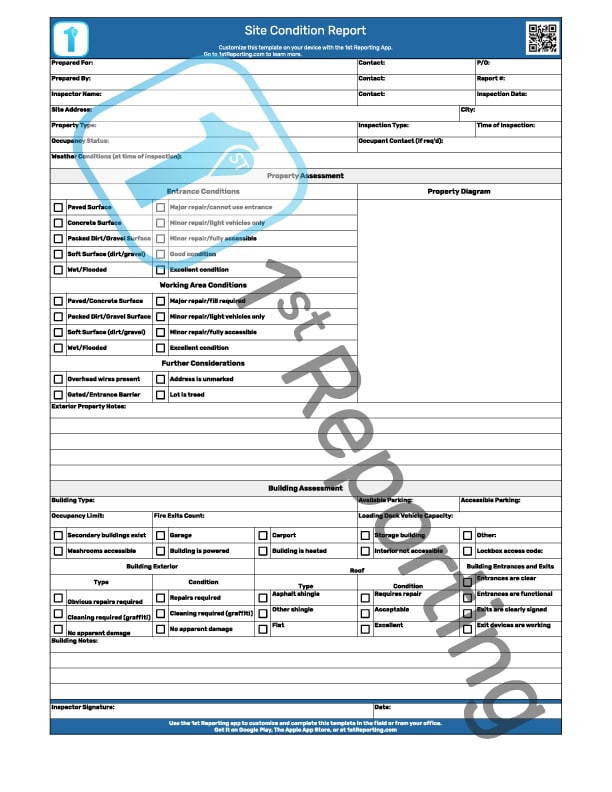Demolition projects require a copious amount of logistics, paperwork, and red tape. So, we decided the preparatory process might work best if a regulations-oriented Preparatory Demolition Checklist tool were available. We couldn’t find a decent one online, so we built our own, and you can download it for use with your company.
The Preparatory Demolition Checklist follows best practices for safety and regulatory compliance with OSHA Standard Number 1926.850 for preparatory demolition operations. You can download the PDF or customize the digital report in the 1st Reporting mobile application.
Stay compliant, and more importantly, keep your team safe with safety tools like our Demolition Checklist for preparatory operations. It’s available in two formats, the downloadable PDF or the customizable version found in our inspection and incident reporting app, 1st Reporting.
Let’s take a look at what’s included in the checklist. As a helpful tool, feel free to bookmark this page and use it as a training guide for your team safety personnel. Using a single training source ensures that your team completes the report correctly and concisely. With everyone working from the same training source, you can expect a standardized set of results consistent with your safety program. Let’s get started with a document overview.
Included In The Demolition Safety Checklist
The Preparatory Demolition Checklist has four primary components. Each component is briefly described below. Review each segment to ensure you understand how to use the inspection document.
Administrative Information
Completing the administrative information portion of the Preparatory Demolition Checklist serves several purposes.
- The information provides a means of organizing the document to attach to a demolition project identification number.
- The information provides a quick overview of the site, contact info, and the name of the safety officer.
- The information provides a timeline of events and links to the compulsory pre-demolition operation Engineering Survey.
- The information provides information to ascertain if the project is on schedule, ahead of target, or delayed.
In order to proceed with the demolition preparations, you must have a certified engineering survey. The demolition preparations may not proceed otherwise.
Demolition Preparation Checklist
Provided an Engineering Survey is completed satisfactorily, the Preparatory Demolition operations continue, with the first item identifying hazards. The items proceed through the requirements of OSHA standard 1926.850. The concept here is to review the items individually and ensure that each item is satisfactorily completed before moving on to the next step. This process ensures that the proper Engineering Survey is completed before demolition preparations begin.
Further Required Preparations
Some specific scenarios may require specialty or customized items added to the demolition project preparations. We’ve included a few open rows here where you can include those more specialized or site-specific preparatory considerations.
Checklist Completion/Sign-Off
The sign-off and completion portion of our Preparatory Demolition Checklist ensures that the proper steps are completed and that the process is certified by the appointed demolition project safety officer.
How To Use The Demolition Safety Checklist

The demolition process involves utilities, engineering, and other logistical considerations. To make it easier, we’ve put together a very basic ‘how-to’ to get you started.
Here are a few steps to consider when starting a demolition project.
- Appoint a demolition project safety officer. Provide the officer with authority to halt any aspect of the project at any time if safety regulations are not met.
- Order an Engineering Survey of the demolition site.
- Review the Engineering Survey to note all requirements.
- Perform a site condition survey and job hazard analysis (JHA).
- Create a fire prevention and evacuation plan for the site.
- Ensure first aid and emergency medical supplies are available on site.
- Ensure that the appropriate amount of first-aid trained personnel is on-site at any time.
- Ensure the site maintains an appropriate amount and type of personal protective equipment (PPE).
- Proceed with the shoring structure as required.
- Have the safety officer complete a preparatory demolition checklist and site inspection.
- Ensure that all components of the Preparatory Demolition Checklist have been satisfactorily completed.
- Commence with demolition operations.
Following these steps can create a standardized process and ensure safe operations. However, each site and project will be different and present its challenges. Furthermore, three lines for customized site-specific preparation points may not suffice. Not to worry, we’ve got you covered. Look at our tips below for customized and mobile reporting solutions – worthwhile when your demolition job sites are spread about the map.
Tips For More Efficient Safety Inspections

We’ve helped many companies and organizations with their incident and inspection reporting. You might say it’s our specialty, but you probably gathered that already. However, there’s more to running an efficient inspection than just filling out a checklist; you and I know that. So, how else can you make your site safety a priority while maintaining efficient and effective operations? As mentioned earlier, we’ve covered you with these tips to help you own your safety practices and efficiently complete inspections and audits.
Plan, Project, and Prepare
Every demolition project can throw a wrench into the best-laid plans; you’ve likely encountered this. However, that doesn’t mean you shouldn’t make a solid action plan. In fact, quite the contrary. It would be best if you planned more until you understand the potential risks and outcomes well.
Plans are so essential that even OSHA acknowledges and demands compulsory pre-demolition preparation engineering survey completion. That’s just one of many reasons to create a solid action plan. Here are a few things to put on the agenda and make an actionable part of your demolition plan:
- Job Hazard Analysis – Have each team member complete a JHA pertaining to their roles and responsibilities.
- Site Condition Audit – Your team should complete a site condition audit daily before commencing their shift. It ensures everyone pays attention to potentially changing site conditions and takes appropriate precautions.
- Daily Equipment Walk-Around – Both vehicles and equipment (especially self-propelled equipment) should receive daily pre-use inspections.
- Daily Fall Arrest Inspection – For harnesses, lanyards, and similar equipment. Each team member who uses critical PPE like fall protection equipment must complete a pre-use inspection each day, regardless of whether they used the equipment the day before or not.
- Training and Refresher Training Checklists – Ensure that all team members have the appropriate training—more on next.
Train & Educate
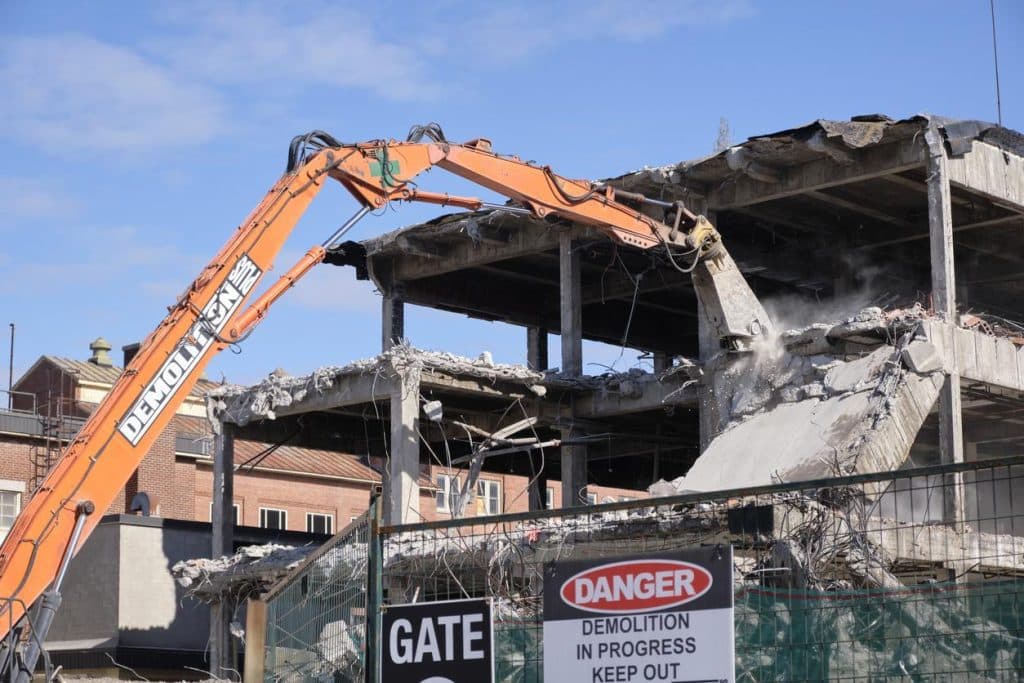
The most valuable tool in your arsenal is knowledge. In fact, it’s everyone’s greatest tool for demolition projects. With safety knowledge, your team can perform optimally while maintaining safe operations. The only way to achieve this symbiotic balance is to subscribe to a robust and regular training and re-training program.
In 2009, GM Waehrer and TR Miller composed a cross-sectional model to analyze the effectiveness of training on incidents at the workplace. They found that “safety training increases the reporting of injuries and illnesses but also has real safety effects on days-away-from-work incidents, especially in smaller firms.” The analysis, published by the Centers for Disease Control and Prevention National Institute for Occupational Safety and Health (NIOSH), shows that proper training can, in fact, help save team members from severe incidents and, thus, injuries.
Pro-Tip: A great way to have everyone on your team on the same page is by having a pre-job safety discussion. Listen to everyone involved and get everyone’s opinion on safety topics and concerns. When you include everyone, everyone is a part of the team, and everyone is safer because of it. It also allows you to address any concerns that may not have come to light until the job is underway.
Communication Is Key
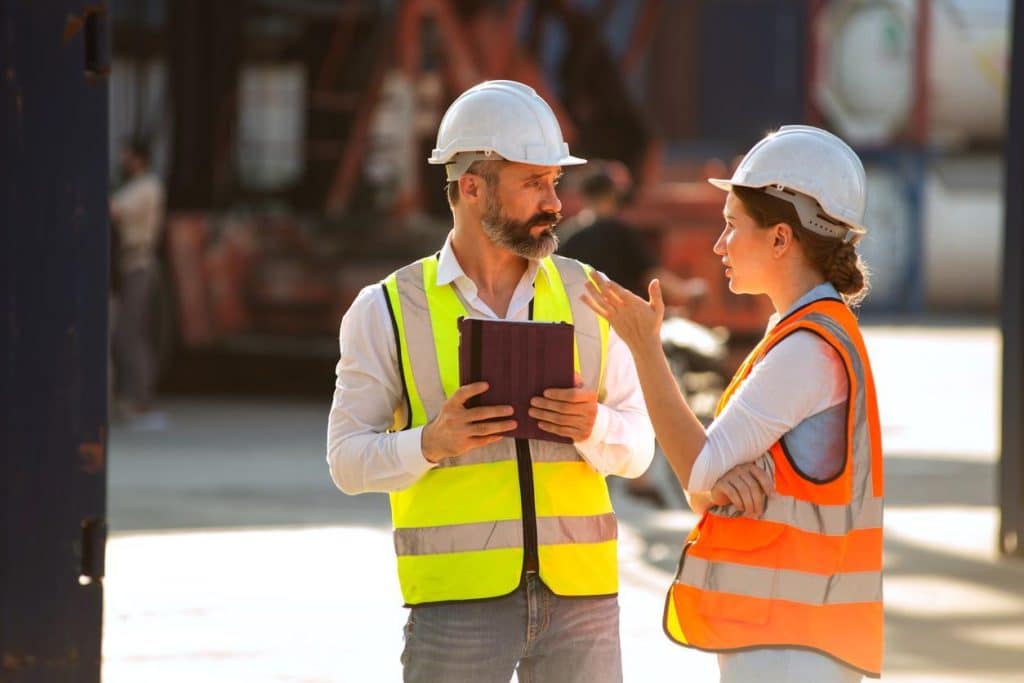
One of the best ways to mitigate safety issues on demolition projects is to create a solid communication system. This action includes providing your team members with the appropriate communications equipment. A smartphone might do for completing mobile forms and inspections using the 1st Reporting app, but it won’t help a team member hear equipment moving behind them if loud sounds are nearby. Nor will the worker hear a warning from their phone if they wear the appropriate hearing protection, which is often highly critical for demolition projects.
The solution is often to incorporate radio equipment that fits in-ear or is incorporated into specialty hearing protective equipment. However, you may want to incorporate a checkpoint system to ensure seamless communication between your teams and the project and safety managers. Here’s how it works:
Checkpoint systems have specific stages of action based on a predetermined set of steps. These specific checkpoints are mapped out on a procedural checklist. Using an inspection and incident reporting application like the industry standard 1st Reporting is one way to mitigate the communication gap. You can do this with the application’s built-in customizable notification settings. You can create a custom procedural checklist and inform team members that they must complete it at the appointed time of their shift. Once they submit their report, the app automatically sends a notification to you or another appointed supervisor of your choice. You can easily monitor your team’s progress with jobs in the field and at remote sites easily and efficiently. We’ll discuss the app in the Right Tools For The Job section below.
Don’t Skip The Small Stuff
One of the worst things you can do is skip a seemingly small ‘infraction’ of safety. At 1st Reporting, we believe in preventive medicine regarding workplace safety – that is, prevention is the best way to defend against at-work incidents. Therefore, it’s essential never to skip safety, no matter how trivial it might seem at the time. Safety issues can creep up and expose our workplace vulnerabilities at the least opportune moment. Prevent it by ensuring a strict safety regimen is installed and practiced.
The Right Tools For The Job

You’ve heard the saying that you need the right tools for the job if you want job success. That couldn’t be more true when it comes to safety. You wouldn’t let an inspector see your team up at height without a harness or under a falling debris hazard with no hard hat – these are just common sense, but the right tools for the job make safety priority number one. You won’t sacrifice a vehicle by removing its brakes, so why would you cut corners when documenting safety? Naturally, you wouldn’t, but are you using the right tools for the job?
Monitoring safety on a demolition site takes perseverance, training, and adherence to strict safety procedures and practices. So, when it comes time to perform that JHA, site condition audit, or even your preparatory demolition checklist, will you settle for hand-written, dirty reports on archaic paper? No, of course not.
1st Reporting is the right tool for documenting, analyzing, and mitigating incidents, documenting inspections and audits, and tracking procedural operations. It’s the tool we wish we had running service crews ten years ago. It’s standard for tomorrow’s companies and organizations. Let me introduce you to 1st Reporting.
1st Reporting is a mobile application that allows you to create dynamic forms, reports, checklists, and other templates. The app lets you disseminate the forms and templates to your appointed users, allowing them to complete the reports anywhere they can operate a mobile or smart device like a phone, tablet, laptop, or desktop computer. Moreover, the application has a robust management dashboard with multiple map views so you can customize the report management experience, seeing what reports were created and where.
Trend analysis is a significant factor in improving safety and operational efficiency. However, suppose you’re still using paper reports. In that case, you’re still wading through manual analysis while your competition uses smart technologies like 1st Reporting to generate customized reports specific to the organization’s needs. With 1st Reporting, we can help you craft the perfect automated reports so you can quickly and effectively manage your operations and safety at a fraction of the cost of manually reviewing reports to pick out the trend data you need.
Don’t take my word for it – try 1st Reporting for yourself and find out how a dynamic form builder and observation collection platform can transform multiple aspects of your operations.
